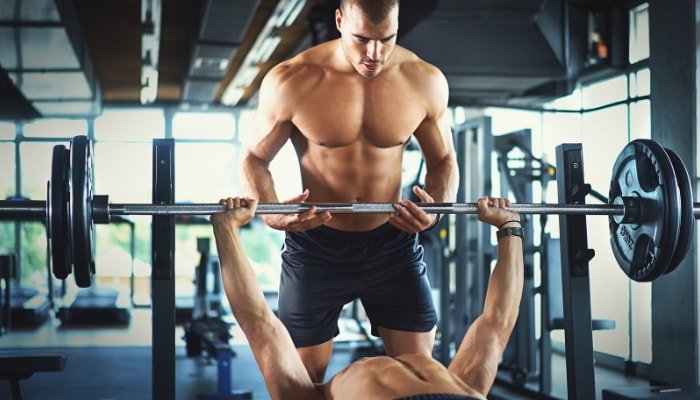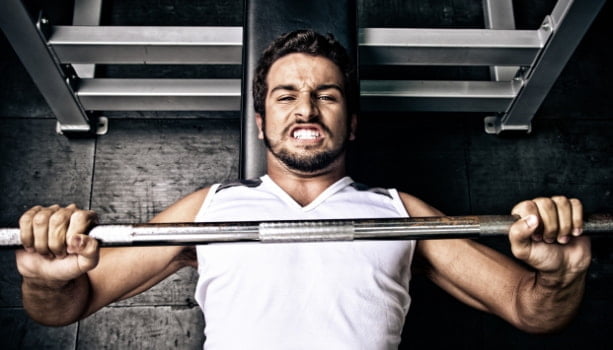Bench press without doubt is one of the most powerful and dominanted exercise you could do at the gym, and to perform it well, you have to learn the correct way to bench press to avoid any injuries.
In this article, I will guide you step by step through the proper technique, tricks, and golden tips for bench press exercise and reach the maximum value out of it.
Table of Contents
What muscle groups and parts that involved in bench press workout
Before I dive into the correct technique for bench press, you have to understand the muscles involved in this exercise. The bench press primarily targets the chest first, then triceps, and shoulders.
- The chest muscles, AKA pectoral muscles, are the primary muscle group targeted during the bench press.
- Triceps: one of our fav. A muscle on the back of your upper arm is also heavily involved in the bench press.
- Shoulders or Deltoids: The shoulders are also involved in the bench press. This exercise helps to build strength and size in your deltoid muscles, particularly the anterior deltoid, which is the front portion of your shoulder.
In addition, If you perform the correct way to bench press, some secondary muscle groups are involved, such as the back, abs, and biceps. These muscle groups help stabilize the body during the exercise and provide support.
Pro tip
don’t do chest workouts after shoulders day, you won’t reach the maximum results, and you might get injured because of overtraining
Picking the Right Weight for Your Bench Press
Long story short, pick the weight you can lift with proper form, and lift it for 8 to 12 repetitions and 3 to 4 sets.
The weight has to be challenging but not too heavy for you; just focus on the form and technique.
When I started back in 2011, I couldn’t even lift the bar itself without assistance, but gradually I could add 2.5 to 5 kilos each time I had a chest day at the gym.
how to set up Your BenchPress

To set up for the bench press exercise, go and lie down on the bench and keep your eyes under the bar. Your feet should be flat on the ground, and you could take off your shoes or wear flat sneakers like all star from Converse brand.
Your back should be in a neutral position, not arched or rounded. Grab the bar with a slightly wider grip than shoulder-width, lift it off the rack, and position it over your chest.
The Correct Way to Bench Press
Now that you mastered the basics, it’s time to perform the bench press. Here’s the step-by-step process:
- Lower the bar towards your chest, keeping your elbows tucked in at a 45-degree angle.
- Pause for a second or two at the bottom of the movement, then push the bar back up to the starting position.
- Repeat the movement for your desired number of reps.
- Control your breath, inhale when the bar is going down, and exhale while you push the bar.
Maintaining the proper form throughout the entire workout movements will help you avoid any possible injury that could occur during bench pressing.
Common Mistakes to Avoid During Bench Press

While performing the workout and performing the correct way to bench press, some bad habits can negatively impact your results and increase the possibility of injuries. Here are some common mistakes to avoid:
- Arching your back.
- Flaring your elbows.
- Lifting your butt off the bench.
- Locking out your elbows at the top of the workout movement.
- Bouncing the bar off your chest.
And to avoid weakness during your workout, you need to eat well before going to the gym and take some beneficial supplements.
Tips and Tricks for Maximizing Your Bench Press Gains
To get the most out of your bench press, focusing on proper form is one of the main factors, but there are also other tips and tricks you can use to maximize your chest muscle gains:
- Warm up at least 10 minutes before you begin your chest workouts.
- Focus on squeezing your chest muscles during the exercise.
- Incorporate different variations of the bench press, such as close-grip or incline press
- experiment with varying widths of grip each time you bench press.
Deadlift is also one of the workouts that you need to consider for overall strength.
FREQUENT QUESTIONS
What is better for bench press, dumbbells, or barbell?
You can do both to bench press with dumbbells or barbells. Depend on more than one way.
Can I bench press if I have shoulder pain?
If you have shoulder pain, it’s best to avoid bench press; it’s better to consult a doctor or physical therapist. In some cases, modify the exercise movements or use a lighter weight.
What is the difference between a flat bench press and an incline bench press?
The flat bench press focuses on all major muscles of the chest. Conversely, the incline bench press targets the upper chest muscles more than the rest of the muscle groups.
How can I increase my bench press weight?
You’ll need to focus on progressive overload to increase your bench press weight. Which means gradually increasing the weight you lift over time. It’s also important to focus on proper form and to include accessory exercises, such as push-ups and dips, to target your chest, triceps, and shoulders.
What are the benefits and outcomes of bench press?
The bench press will increase your strength and improve your chest muscle’s endurance, not only your chest muscles but also your arms and shoulders.
Wrapping up
The bench press is an old-school and favorite exercise for many of us and is considered the main workout for building a strong and defined upper body.
By understanding the muscles involved, choosing the right weight wisely, positioning your body correctly, and using the correct technique, you’ll be able to get the most out of your bench press. Remember to avoid common mistakes and use the tips and tricks I mentioned earlier to maximize your chest gains.
Do not ask anyone, at least in the beginning, The Correct Way to Bench Press. It must come from a trusted guru or personal trainer.
Go and unleash the beast inside you, always try to enjoy your time at the gym, take some selfies and post online if you want great fitness and gym quotes for your post.
References:
The Effects of Bench Press Variations in Competitive Athletes on Muscle Activity and Performance https://www.ncbi.nlm.nih.gov/pmc/articles/PMC5504579/
(PDF) Analysis of muscle activity during the bench press




